
Do Condoms Protect Against STIs? Unlocking Internal Truths
Ah, the power of protection. Protection isn’t just a feeling, it’s a lifestyle. Everyone deserves to feel shielded among the sea of STIs that float around everywhere. Thankfully, condoms are one of your best defences (on top of other suggestions that can help reduce risks). When it comes to safeguarding yourself against STIs, condoms are like the superheroes of the bedroom – they wear a protective cape and know how to keep the bad guys at bay. Bad guys are referring to sexually transmitted infections, not the ones you may or may not bring home. When it comes to being a sexual health advocate, nothing feels better.
These trusty protective barriers are proven to lower the probability of contracting diseases, but they work best when there’s a backup squad at play. While wrapping it up is an essential step in pleasure time, it’s not the only strict line of defence. Dive into how condoms reduce your STI risk, uncover whether you can get an STI with a condom on or not, and explore other smart strategies to help keep you worry-free when you go for a ride.
Can You Get An STI With A Condom? And Other Preventative Methods Explained
While condoms, including those made by Durex®*, are effective in preventing the probability of STIs from happening, they’re still not 100% preventable. Even when using a condom properly (consult the trusty Fit Tool when in doubt), STIs may still be contracted through skin-to-skin contact by another part of the body that condoms don’t come in contact with. STIs can be transmitted via contact with the lips, vulva, or anus – specifically if the person has an open herpes infection. While condoms protect against most STIs, it’s important to do your research and speak to your partner(s) in advance and ask about their STI status to lessen your risks.
For more advice on condom safety and best practices, thoroughly read Protection 101: How Safe Are Condoms?
How Do Latex Condoms Protect You?
Latex condoms, like Durex® Sensi-Thin®* made of natural latex, are designed using latex rubber that can be effective in protecting you, and your partner(s), from potential STIs. Most Durex® condoms are made with latex, and can be used with silicone or water-based lubricants to ensure smoothness. Latex condoms provide a protective barrier over skin and mucous membranes, as well as semen. 100% of Durex® condoms are electronically tested with five more quality tests carried out on every batch to provide you with the utmost safety in your times of pure passion.
How Do Non-Latex Condoms Protect You?
Some people may be allergic to latex, so another condom option is available to help protect against STIs: Durex® Real Feel®, Natural Latex-Free Condoms*. Part of the non-latex family, these good guys are made with polyisoprene and are lubricated to help offer a natural skin-on-skin feeling and a smoother sexual experience (all while helping protect against STIs). The technologically advanced non-latex ingredient maximizes pleasure while keeping unwanted infections at bay, when used properly.
If you’re looking for more in-depth information about the different types of STIs out there, or wondering what more condoms can do for you as a means of protection, check out Do Condoms Prevent STDs?
What Do I Do If A Condom Breaks?
In the case of condom breakage, here are a few important tidbits to remember so you can reduce the risk of STIs or unwanted pregnancy:
- Stop immediately – as soon as you feel the condom broke, quit sexual activity to prevent further exposure
- Assess the situation – determine whether there was any potential exposure to semen or other fluids
- Consider emergency contraception – determine whether or not a morning-after pill is needed after consultation with your healthcare provider or pharmacist
- Do STI testing – if either you or your partner(s) are at risk of STIs, book an appointment or do walk-in testing and know your window period
- See a healthcare provider – if you have any concerns about next steps, it’s wise to consult your doctor for personalized advice
- Check the condom thoroughly for the next time – for future reference, always check the condom’s expiration date and packaging before use and ensure it’s applied correctly (even with additional lube) to reduce breakage
Other Methods You Can Consider To Help Protect Against STIs
It’s always best to know your options when it comes to protecting yourself and your sexual partner(s), so here are some other potential defences against STIs you can dig into when paired with condoms:
- Hepatitis B vaccine – recommended for those sexually active with multiple partners or being treated for STIs
- HPV vaccine – recommended for those younger (aged 11 or 12) and without any previous vaccination
- Internal condoms – can help reduce STIs or HIV when paired with external condoms
Check out more Durex® educational content to learn how you can stay protected from common STIs:
- Chlamydia: How To Spot & Prevent This Common STI
- Gonorrhea: How To Spot & Prevent This Common STI
- It’s A Wrap: Why And How To Use A Condom
Serve And Protect Yourself
After answering yes to “do condoms protect against STIs” when used consistently and correctly, as well as discussing the two popular styles along with other preventative measures, you can now move forward to protect yourself and share this info with others. However, for comprehensive protection, it’s essential to complement condom use with regular STI screenings, open communication with sexual partners, and keeping up-to-date about sexual health. By taking these proactive steps, you can empower yourself. Nothing feels better than maintaining a satisfied well-being.
Curious to know how to effectively treat common STIs you may or may not come in contact with? Listen to sexual educator Natalya Mason explain the breakdown in Symptoms, Treatments And Long Term Effects For Each Kind Of STI.
*Ensure this product is right for you. Always read and follow the label before use.

